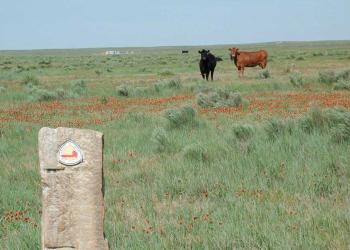About the Grasslands
About the Cimarron and Comanche National Grasslands
A Short History of the Grasslands
“The ultimate meaning of the dust storms of the 1930s was that America as a whole, not just the plains, was badly out of balance with its natural environment. Unbounded optimism about the future, careless disregard of nature’s limits and uncertainties, uncritical faith in Providence, devotion to self-aggrandizement–all these were national as well as regional characteristics.”
—Donald Worster, The Wealth of Nature: Environmental History and the Ecological Imagination
The grasslands are two of the 20 national grasslands managed by the USDA Forest Service. The grasslands are ongoing ecosystem restoration projects whose existence, spawned by the Dust Bowl recovery efforts, reminds us daily of the importance of caring for the land. They also provide forage, wildlife habitat, recreation, energy and tangible bonds with our past. The history and the heritage of the grasslands connect us with the uniquely rich cultures that—then and now—shape these grasslands and nearby communities.
The legacies of adapting to life on the high plains for the past 12,000 years by numerous cultural and ethnic groups form the multicultural roots of the grasslands and the surrounding communities. Throughout the grasslands, we continue to discover, document and protect the physical remains of the ecological, geological and human histories of the area, such as dinosaur trackways and skeletons, rock art, middens,[1] cemeteries, early ranches and homesteads.
[1] Middens on the grasslands are areas where collections of thousands or or even tens of thousands of discarded tools and food refuse items have been found.
Cimarron National Grassland

The Cimarron National Grassland is one of 20 national grasslands administered by the U.S. Forest Service. The district manages about 108,175 acres in Morton and Stevens counties in southwestern Kansas. It is the state's largest area of public land and the only parcel managed by the Forest Service.
Comanche National Grassland

The Comanche National Grassland includes over 440,000 acres in southeastern Colorado. On the Comanche National Grassland, you can explore southeastern Colorado's rich history. The grassland has many stories to tell, from dinosaurs roaming the shoreline of a vast lake 150 million years ago to Mexican and American traders traveling the Santa Fe Trail 150 years ago.
More than meets the eye

At first glance, a person looking out at the Comanche and Cimarron National Grasslands might notice areas of sparse grass, numerous fences and scattered cows. But on closer look and with a little more time, visitors might see a hidden flower blossom, find a relic from the last century or spot one of a surprising number of wildlife species. They also might discover the interesting history and draw of these unique, tranquil places.


